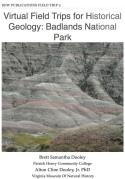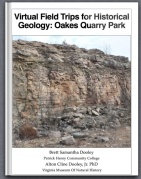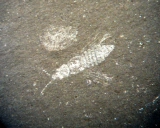 We returned to Carmel Church today to begin another 2-week excavation. After our dig last April we left a tarp up covering the pit. That turned out to be a mistake, as we discovered upon entering the site (above).
We returned to Carmel Church today to begin another 2-week excavation. After our dig last April we left a tarp up covering the pit. That turned out to be a mistake, as we discovered upon entering the site (above).
Even so, with some ingenuity and scrounging around through our old equipment (we rarely throw anything away), we were able to put together a replacement tarp frame in a couple of hours (below), saving several hundred dollars of my budget that can now be put to better use.
 After removing a couple of tons of overburden, we got into a very weathered part of the bonebed in the afternoon and found some rib fragments, but we haven’t uncovered anything identifiable at this point. But that wasn’t actually the biggest news today.
After removing a couple of tons of overburden, we got into a very weathered part of the bonebed in the afternoon and found some rib fragments, but we haven’t uncovered anything identifiable at this point. But that wasn’t actually the biggest news today.
Rose Schooff owns land in New Kent County, VA that has exposures of the Pliocene Yorktown and Miocene Eastover Formations. She met us at the hotel this morning to donate a new specimen she found a few weeks ago with her cousin Christie Aldridge-Nunn:

 This is a partial gomphothere tooth (occlusal view at the top, lateral view above). Gomphotheres are an extinct group of four-tusked elephants that were common in North America beginning in the Middle Miocene. Here’s a more complete specimen from the University of Nebraska State Museum:
This is a partial gomphothere tooth (occlusal view at the top, lateral view above). Gomphotheres are an extinct group of four-tusked elephants that were common in North America beginning in the Middle Miocene. Here’s a more complete specimen from the University of Nebraska State Museum:
 While gomphotheres are common in North America, they are quite rare in east coast deposits because of the general lack of Miocene terrestrial sediments. There are several known from the Calvert and Choptank Formations in Maryland, and one specimen that I know of from the Calvert in Virginia; although alas, not (yet) from Carmel Church. (There are reports of privately-held specimens from Virginia, but those are not in museums where they can be studied and their age and identities confirmed.) So as far as I know Rose and Christie’s specimen is only the second gomphothere specimen from Virginia in a museum collection.
While gomphotheres are common in North America, they are quite rare in east coast deposits because of the general lack of Miocene terrestrial sediments. There are several known from the Calvert and Choptank Formations in Maryland, and one specimen that I know of from the Calvert in Virginia; although alas, not (yet) from Carmel Church. (There are reports of privately-held specimens from Virginia, but those are not in museums where they can be studied and their age and identities confirmed.) So as far as I know Rose and Christie’s specimen is only the second gomphothere specimen from Virginia in a museum collection.
That’s actually not the most remarkable thing about this specimen, however. The New Kent County gomphothere is not from the Middle Miocene Calvert or Choptank Formation like all the other gomphotheres from this area, but instead from the Late Miocene Eastover Formation (2-3 million years younger). As far as I know, there are no published reports of land mammals of any kind from the Eastover (I have seen a few in museum collections, but not gomphotheres). In fact, other than this specimen the only occurrences of Late Miocene gomphotheres in the entire southeastern US that I know of are several specimens from Florida and one specimen from Gray Fossil Site in Tennessee. The New Kent County tooth therefore represents a significant new record of the distribution of late Miocene gomphotheres.
I’d like to thank Rose and Christie for donating this very significant specimen to VMNH.









